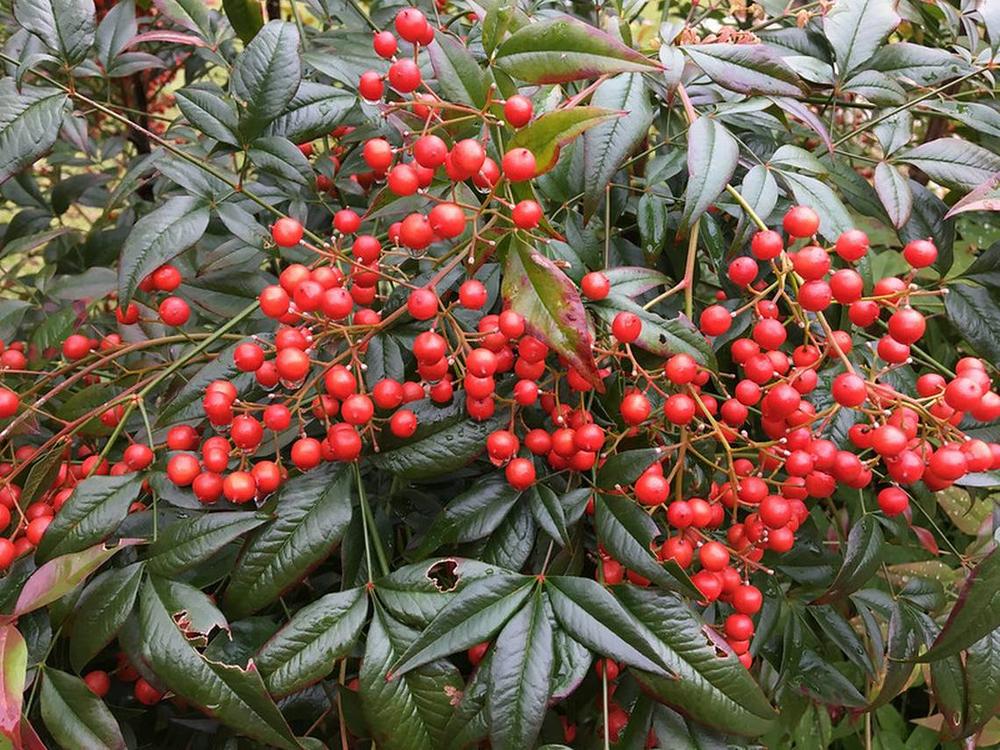
Caption
Nandina domestica’s red berries contain cyanide, which is often deadly for birds and pets.
Credit: Scott Zona / Courtesy of the NC Botanical Garden

Nandina domestica’s red berries contain cyanide, which is often deadly for birds and pets.
Winter is often full of muted, dull colors and frigid temperatures. But one common yard bush brings the color back into the dreary season. However, its beauty comes with a price, as it is actually toxic to certain wildlife and humans.
Here’s what to know about the invasive bush, how to identify it and remove it from your yard.
According to Southern Living, the Nandina bush is an evergreen shrub that is native to China, India and Japan and thus, in the U.S., it is non-native and invasive.
The bushes are frequently used to spruce up a dull landscape or lackluster yard, but the beautiful red berries on the Nandina bush are toxic to birds, humans and other animals.
“Nandina berries contain a tiny amount of cyanide along with other alkaloids that produce hydrogen cyanide (HCN) which is a highly toxic substance to all humans and animals,” said Steve Bender with Southern Living.
Bender said that although a few berries can make birds very sick, it will rarely kill them, but a lot at once could cause a fatal overdose. And some birds are ravenous, fast eaters.
“Cedar waxwings don’t stop with a couple or three. If you’ve ever seen a swarm of these highly social birds descend upon a garden, you know they will strip a holly, crabapple, dogwood, or other berry-laden plant in mere minutes,” Bender said.
Of course, if the berries are poisonous to birds, they are toxic to pets, too. Bender said to keep your pets far away from the Nandina bush, but if you suspect your pet has consumed Nandina berries, it is best to call your veterinarian immediately.
And worst of all, if you think a small child has ingested any, call a doctor or take them to a hospital.
Here’s more about how to identify Nandina bushes and how to protect your yard:
If you are trying to see if you have a Nandina bush in your yard or trying to avoid mistakenly planting one, here’s how they look:

Nandina domestica’s red berries contain cyanide, which is often deadly for birds and pets.
The U.S. Forest Service said that the Nandina bush is “tall, with relatively slender, unbranched stems.” It can grow up to seven feet tall and has leaves that are 20 to 30 inches long. Once the bush grows berries, the berries can be bright red in color or have a purple tint.
Sure, they’re pretty, but they are also toxic, so if you’re looking for ways to remove the Nandina bush, here’s what to do:
“At the very least, cut off and dispose of the clusters of nandina berries that appear on your plants before the birds find them,” said Terry W. Johnson with the Georgia Wildlife Resources Division.
Look for the white flowers on the bush that grow in the spring and prune them. That way, no flowers will bloom and that means, no berries will grow.
Removing the whole Nandina bush from your yard is also an option, but it could be a pretty taxing task.
“Seedlings and small plants can be hand-pulled or dug up—just know that it’s difficult to remove every inch of the root system, and you may have to do it again if a new sprout pops up,” said Bender.
Bender recommended purchasing herbicide and spraying the remnants of the plant and roots if you can’t quite dig it all up to remove it.
If your yard looks bare after removing the bush and you miss the color, consider planting a holly bush that isn’t toxic to wildlife.
Do you have more questions about yard bushes? Let me know in the comments or email me at cmadden@mcclatchy.com.
This story comes to GPB through a reporting partnership with the Macon Telegraph.